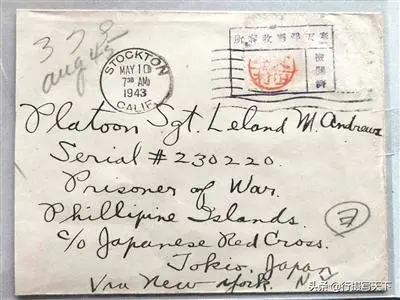Zhang Guangsheng carefully took out a well-preserved envelope dating back 77 years when flames of the Second World War (WWII), the deadliest in history, were raging everywhere.
A black postmark can be seen on the upper-left corner of this fading, brownish-yellow hued envelope, which is about 6.2 cm long and 5.5 cm in width.
The letter was sent from Stockton, California, on May 10, 1943. It was a letter from home to an American prisoner of war (POW) who had been held at a notorious POW camp in northeast China.
Zhang, a private collector in Shenyang, capital of northeast China's Liaoning Province, aims to offer people a glimpse into the history of the Shenyang World War II Allied Prisoners Camp through the envelope. The camp was originally known as Mukden POW Camp among the Japanese.
Operated by the Japanese army, the Shenyang camp also got its name "oriental Auschwitz" after the notorious Auschwitz concentration camp in Poland, the biggest of its kind built by Nazi Germany during WWII.
More than 2,000 allied POWs from countries including the United States, the United Kingdom, Australia, the Netherlands, Canada and New Zealand, all captured in the Pacific War, were held at the camp between November 1942 and August 1945.
The POWs suffered brutal enslavement at the camp and about 260 of them died of diseases, cold, starvation and torture.
The letter's long journey was full of twists and turns. It was posted from San Francisco in May 1943, then passed on to the Japanese Red Cross Society via New York, before being handed over to the American soldier captured by Japanese troops on the Philippine battlefield.
The postmark bears a tiny note --"379, Aug. 45" -- handwritten with pencil, indicating that the possible time of the letter's arrival was August 1945, Zhang said, noting that "379" was the American POW's number at the Shenyang camp.
According to the staff at the Shenyang World War II Allied Prisoners Camp Site Museum, the name of prisoner 379 is Leland Andrews, a U.S. military sergeant. No other information is available about him.
A message reading "Mukden POW Camp," "Censored, read and delivered" and "Tamura" in a rectangular stamp is clearly visible on the upper-right corner of the envelope.
The letter crossed the Pacific Ocean during the war and traveled for more than two years, Zhang said, adding that it was finally delivered to Leland Andrews after the Japanese surrendered. "You can imagine how he might have felt when he saw this letter from home."
Zhang said that it is impossible to know what exactly Andrews' family had written in the letter, but they must have expressed their hopes for the war to end and the family to be reunited.
As the 75th anniversary of Japan's surrender in WWII approaches, Zhang wishes to find Leland Andrews' family and return the envelope to its owner.
"Just as a famous Chinese poem says, the beacon fire has gone higher and higher, and words from household are worth their weight in gold," Zhang said. "This letter, full of love, should be returned to his family."
 简体中文
简体中文

